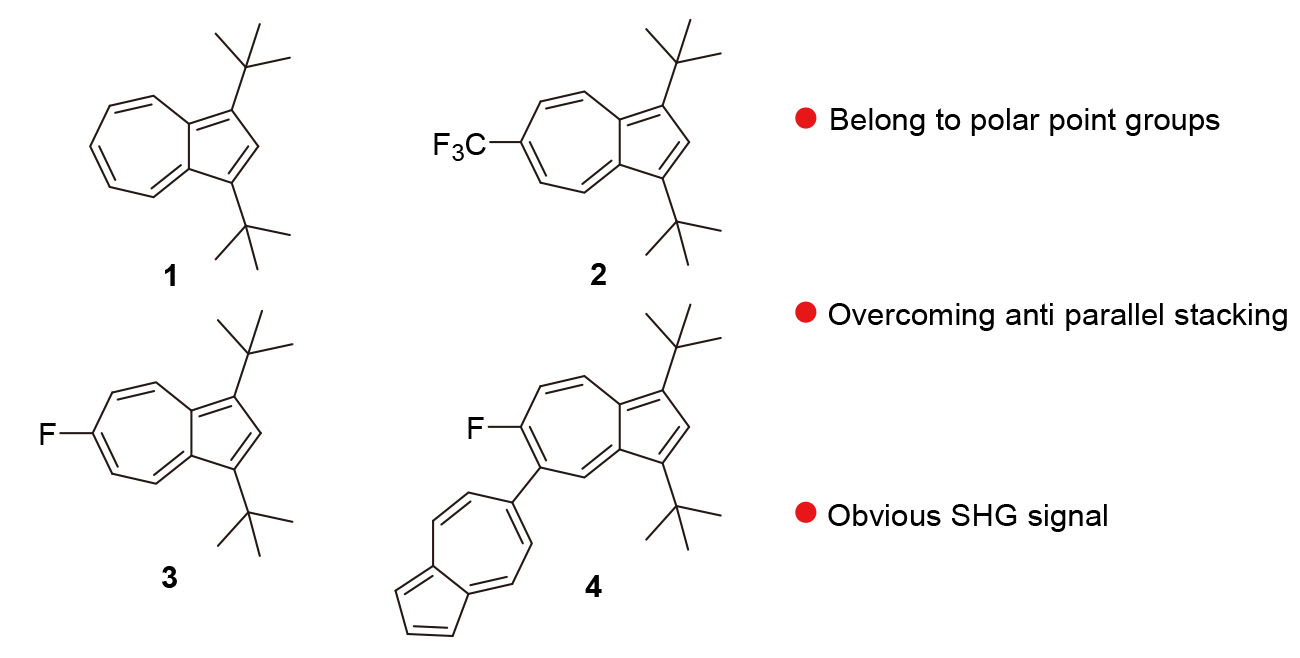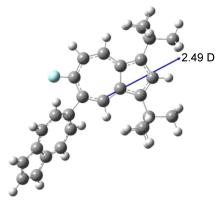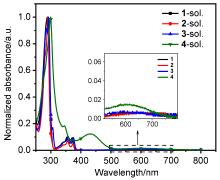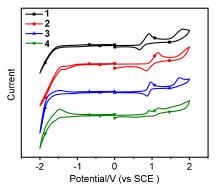有机化学 ›› 2025, Vol. 45 ›› Issue (4): 1297-1305.DOI: 10.6023/cjoc202407022 上一篇 下一篇
研究论文
谢玉龙a,b, 向焌钧b, 宋贤江c,*( ), 张含悦d,*(
), 张含悦d,*( ), 高希珂b,*(
), 高希珂b,*( )
)
收稿日期:2024-07-09
修回日期:2024-09-27
发布日期:2024-10-29
基金资助:
Yulong Xiea,b, Junjun Xiangb, Xianjiang Songc( ), Hanyue Zhangd(
), Hanyue Zhangd( ), Xike Gaob(
), Xike Gaob( )
)
Received:2024-07-09
Revised:2024-09-27
Published:2024-10-29
Contact:
* E-mail: Supported by:文章分享

薁是一种为数不多的全碳型偶极分子, 有望通过分子的偶极叠加实现铁电性. 通过理性分析, 设计合成了4个1,3-二叔丁基薁类衍生物, 分别为1,3-二叔丁基薁(1)、1,3-二叔丁基-6-三氟甲基薁(2)、1,3-二叔丁基-6-氟薁(3)和1,3-二叔丁基-5-(6'-薁)基-6-氟薁(4). 这些化合物分别结晶于Aba2、Fdd2、Pna21和Cc空间群, 均属于10个极性点群, 且在晶体中均克服了反平行堆积, 具有宏观极化, 其中化合物4以分子偶极一致的方式堆积, 表明大位阻叔丁基团的引入有效降低了分子间偶极-偶极相互作用. 化合物1和4在300 K时具有明显的二次谐波产生(SHG)信号, 约为典型无机铁电体磷酸二氢钾(KDP)的1/4和2/3. 这些研究结果表明, 在薁单元上进行含氟基团取代和5-位修饰都是使薁类衍生物结晶于10个极性点群的有效策略, 为发展新型薁类有机铁电体提供了研究思路.
谢玉龙, 向焌钧, 宋贤江, 张含悦, 高希珂. 1,3-二叔丁基薁类衍生物的设计合成及性质研究[J]. 有机化学, 2025, 45(4): 1297-1305.
Yulong Xie, Junjun Xiang, Xianjiang Song, Hanyue Zhang, Xike Gao. Design, Synthesis, and Properties of 1,3-Di-tert-butylazulene Derivatives[J]. Chinese Journal of Organic Chemistry, 2025, 45(4): 1297-1305.
| Compd. | Temperature/K | Crystal system | Point group | Space group |
|---|---|---|---|---|
| 1 | 213 | Orthorhombic | mm2 | Aba2 |
| 2 | 213 | Orthorhombic | mm2 | Fdd2 |
| 3 | 293 | Orthorhombic | mm2 | Pna21 |
| 4 | 173 | Monoclinic | m | Cc |
| Compd. | Temperature/K | Crystal system | Point group | Space group |
|---|---|---|---|---|
| 1 | 213 | Orthorhombic | mm2 | Aba2 |
| 2 | 213 | Orthorhombic | mm2 | Fdd2 |
| 3 | 293 | Orthorhombic | mm2 | Pna21 |
| 4 | 173 | Monoclinic | m | Cc |


| Compd. | λmaxa/nm | ε/(L•mol-1•cm-1) | λedge/nm | $E_{\text{g}}^{\text{opt}}$b/eV | EHOMOc/eV | ELUMOd/eV |
|---|---|---|---|---|---|---|
| 1 | 288 | 1.18×105 | 808 | 1.53 | -5.17 | -3.64 |
| 2 | 290 | 9.57×104 | 867 | 1.43 | -5.38 | -3.95 |
| 3 | 292 | 7.24×104 | 764 | 1.62 | -5.30 | -3.68 |
| 4 | 299 | 1.22×105 | 756 | 1.64 | -5.20 | -3.56 |
| Compd. | λmaxa/nm | ε/(L•mol-1•cm-1) | λedge/nm | $E_{\text{g}}^{\text{opt}}$b/eV | EHOMOc/eV | ELUMOd/eV |
|---|---|---|---|---|---|---|
| 1 | 288 | 1.18×105 | 808 | 1.53 | -5.17 | -3.64 |
| 2 | 290 | 9.57×104 | 867 | 1.43 | -5.38 | -3.95 |
| 3 | 292 | 7.24×104 | 764 | 1.62 | -5.30 | -3.68 |
| 4 | 299 | 1.22×105 | 756 | 1.64 | -5.20 | -3.56 |




| [1] |
(a) Anderson, A. G. Jr.; Steckler, B. M. J. Am. Chem. Soc. 1959, 81, 4941.
|
|
(b) Wang, Y.; Xiang, J.; Ge, C.; Gao, X. Acta Chim. Sinica 2023, 81, 1341 (in Chinese).
|
|
|
(汪洋, 向焌钧, 葛从伍, 高希珂, 化学学报, 2023, 81, 1341.)
doi: 10.6023/A23060292 |
|
|
(c) Xin, H.; Hou, B.; Gao, X. Acc. Chem. Res. 2021, 54, 1737.
|
|
|
(d) Xin, H.; Gao, X. ChemPlusChem 2017, 82, 945.
|
|
|
(e) Peng, P.; Li, J.; Hou, B.; Xin, H.; Cheng, T.; Gao, X. Chin. J. Org. Chem. 2020, 40, 3916 (in Chinese).
|
|
|
(彭培珍, 李晶, 侯斌, 辛涵申, 程探宇, 高希珂, 有机化学, 2020, 40, 3916.)
doi: 10.6023/cjoc202005014 |
|
|
(f) Gao, H.; Yang, X.; Xin, H.; Gao, T.; Gong, H.; Gao, X. Chin. J. Org. Chem. 2018, 38, 2680 (in Chinese).
|
|
|
(高洪磊, 杨笑迪, 辛涵申, 高铁阵, 龚和贵, 高希珂, 有机化学, 2018, 38, 2680.)
doi: 10.6023/cjoc201805004 |
|
|
(g) Xin, H.; Ge, C.; Fu, L.; Yang, X.; Gao, X. Chin. J. Org. Chem. 2017, 37, 711 (in Chinese).
|
|
|
(辛涵申, 葛从伍, 傅丽娜, 杨笑迪, 高希珂, 有机化学, 2017, 37, 711.)
doi: 10.6023/cjoc201609029 |
|
| [2] |
Ou, L.; Zhou, Y.; Wu, B.; Zhu, L. Chin. Chem. Lett. 2019, 30, 1903.
|
| [3] |
(a) Schwarz, F.; Koch, M.; Kastlunger, G.; Berke, H.; Stadler, R.; Venkatesan, K.; Lörtscher, E. Angew. Chem., Int. Ed. 2016, 55, 11781.
|
|
(b) Yang, G.; Sangtarash, S.; Liu, Z.; Li, X.; Sadeghi, H.; Tan, Z.; Li, R.; Zheng, J.; Dong, X.; Liu, J.; Yang, Y.; Shi, J.; Xiao, Z.; Zhang, G.; Lambert, C.; Hong, W.; Zhang, D. Chem. Sci. 2017, 8, 7505.
|
|
|
(c) Freysoldt, C.; Merz, P.; Schmidt, M.; Mohitkar, S.; Felser, C.; Neugebauer, J.; Jansen, M. Angew. Chem., Int. Ed. 2019, 58, 1.
|
|
|
(d) Huang, C.; Jevric, M.; Borges, A.; Olsen, S. T.; Hamill, J. M.; Zheng, J.-T.; Yang, Y.; Rudnev, A.; Baghernejad, M.; Broekmann, P.; Petersen, A. U.; Wandlowski, T.; Mikkelsen, K. V.; Solomon, G. C.; Brøndsted Nielsen, M.; Hong, W. Nat. Commun. 2017, 8, 15436.
|
|
|
(e) Zhang, C.; Cheng, J.; Wu, Q.; Hou, S.; Feng, S.; Jiang, B.; Lambert, C. J.; Gao, X.; Li, Y.; Li, J. J. Am. Chem. Soc. 2023, 145, 1617.
|
|
| [4] |
(a) Zieliński, T.; Kȩdziorek, M.; Jurczak, J. Chem.-Eur. J. 2008, 14, 838.
pmid: 29770986 |
|
(b) Lichosyt, D.; Wasiłek, S.; Dydio, P.; Jurczak, J. Chem.-Eur. J. 2018, 24, 11683.
doi: 10.1002/chem.201801460 pmid: 29770986 |
|
| [5] |
(a) Yamaguchi, Y.; Maruya, Y.; Katagiri, H.; Nakayama, K.-I.; Ohba, Y. Org. Lett. 2012, 14, 2316.
doi: 10.1021/ol3007327 pmid: 27511286 |
|
(b) Yamaguchi, Y.; Ogawa, K.; Nakayama, K.-I.; Ohba, Y.; Katagiri, H. J. Am. Chem. Soc. 2013, 135, 19095.
doi: 10.1021/ja410696j pmid: 27511286 |
|
|
(c) Yamaguchi, Y.; Takubo, M.; Ogawa, K.; Nakayama, K.-I.; Koganezawa, T.; Katagiri, H. J. Am. Chem. Soc. 2016, 138, 11335.
doi: 10.1021/jacs.6b06877 pmid: 27511286 |
|
|
(d) Yao, J.; Cai, Z.; Liu, Z.; Yu, C.; Luo, H.; Yang, Y.; Yang, S.; Zhang, G.; Zhang, D. Macromolecules 2015, 48, 2039.
pmid: 27511286 |
|
|
(e) Shoji, T.; Ito, S. Sci. China: Chem. 2018, 61, 973.
pmid: 27511286 |
|
|
(f) Schulz, F.; Takamaru, S.; Bens, T.; Hanna, J.-I.; Sarkar, B.; Laschat, S.; Iino, H. Phys. Chem. Chem. Phys. 2022, 24, 23481.
pmid: 27511286 |
|
| [6] |
(a) Yang, C.-C.; Ma, J.-Y.; Su, X.; Zheng, X.-L.; Chen, J.; He, Y.-Y.; Tian, W.-Q.; Li, W.-Q.; Yang, L. FlatChem 2022, 33, 100362.
|
|
(b) Yang, C.-C.; Li, L.; Tian, W. Q.; Li, W.-Q.; Yang, L. Phys. Chem. Chem. Phys. 2022, 24, 13275.
|
|
| [7] |
(a) Wang, F.; Lin, T. T.; He, C.; Chi, H.; Tang, T.; Lai, Y.-H. J. Mater. Chem. 2012, 22, 10448.
|
|
(b) Ince, M.; Bartelmess, J.; Kiessling, D.; Dirian, K.; Martínez- Díaz, M. V.; Torres, T.; Guldi, D. M. Chem. Sci. 2012, 3, 1472.
|
|
|
(c) Yao, Y.; Zhang, Y.; Zhang, J.; Yang, X.; Ding, D.; Shi, Y.; Xu, H.; Gao, X. ACS Appl. Mater. Interfaces 2022, 14, 19192.
|
|
|
(d) Gao, H.; Yao, Y.; Li, C.; Zhang, J.; Yu, H.; Yang, X.; Shen, J.; Liu, Q.; Xu, R.; Gao, X.; Ding, D. Angew. Chem., Int. Ed. 2024, 63, e202400372.
|
|
| [8] |
(a) Seidel, J.; Fu, D.; Yang, S.-Y.; Alarcón-Lladó, E.; Wu, J.; Ramesh, R.; Ager, J. W. Phys. Rev. Lett. 2011, 107, 126805.
pmid: 17755995 |
|
(b) Choi, T.; Lee, S.; Choi, Y. J.; Kiryukhin, V.; Cheong, S.-W. Science 2009, 324, 63.
doi: 10.1126/science.1168636 pmid: 17755995 |
|
|
(c) Scott, J. F. Science 2007, 315, 954.
pmid: 17755995 |
|
|
(d) Scott, J. F.; Paz de Araujo, C. A. Science 1989, 246, 1400.
pmid: 17755995 |
|
|
(e) Whatmore, R. W. Rep. Prog. Phys. 1986, 49, 1335.
pmid: 17755995 |
|
| [9] |
Shi, P.-P.; Tang, Y.-Y.; Li, P.-F.; Liao, W.-Q.; Wang, Z.-X.; Ye, Q.; Xiong, R.-G. Chem. Soc. Rev. 2016, 45, 3811.
|
| [10] |
(a) Thomas, S.; Ramasesha, S.; Hallberg, K.; Garcia, D. Phys. Rev. B 2012, 86, 180403.
pmid: 18432209 |
|
(b) Bühl, M.; Koźmiński, W.; Linden, A.; Nanz, D.; Sperandio, D.; Hansen, H.-J. Helv. Chim. Acta 1996, 79, 837.
pmid: 18432209 |
|
|
(c) Dyker, G.; Borowski, S.; Heiermann, J.; Körning, J.; Opwis, K.; Henkel, G.; Köckerling, M. J. Organomet. Chem. 2000, 606, 108.
pmid: 18432209 |
|
|
(d) Adachi, T.; Saitoh, H.; Yamamura, Y.; Hishida, M.; Ueda, M.; Ito, S.; Saito, K. Bull. Chem. Soc. Jpn. 2013, 86, 1022.
pmid: 18432209 |
|
|
(e) Horiuchi, S.; Tokura, Y. Nat. Mater. 2008, 7, 357.
doi: 10.1038/nmat2137 pmid: 18432209 |
|
|
(f) Horiuchi, S.; Tokunaga, Y.; Giovannetti, G.; Picozzi, S.; Itoh, H.; Shimano, R.; Kumai, R.; Tokura, Y. Nature 2010, 463, 789.
pmid: 18432209 |
|
|
(g) Fu, D.-W.; Cai, H.-L.; Liu, Y.; Ye, Q.; Zhang, W.; Zhang, Y.; Chen, X.-Y.; Giovannetti, G.; Capone, M.; Li, J.; Xiong, R.-G. Science 2013, 339, 425.
pmid: 18432209 |
|
|
(h) Ye, H.-Y.; Tang, Y.-Y.; Li, P.-F.; Liao, W.-Q.; Gao, J.-X.; Hua, X.-N.; Cai, H.; Shi, P.-P.; You, Y.-M.; Xiong, R.-G. Science 2018, 361, 151.
pmid: 18432209 |
|
| [11] |
Danzmann, S.; Liebing, P.; Engelhardt, F.; Hilfert, L.; Edelmann, F. T. Inorg. Chem. Commun. 2019, 99, 176.
doi: 10.1016/j.inoche.2018.11.021 |
| [12] |
Förster, S.; Seichter, W.; Kuhnert, R.; Weber, E. J. Mol. Struct. 2014, 1075, 63.
|
| [13] |
Voss, J.; Pesel, T.; Buddensiek, D.; Lehtivarjo, J. Z. Naturforsch., : J. Chem. Sci. 2015, 70, 441.
|
| [14] |
Tsuchiya, T.; Katsuoka, Y.; Yoza, K.; Sato, H.; Mazaki, Y. Chem- PlusChem 2019, 84, 1659.
|
| [15] |
Hou, B.; Li, J.; Xin, H.; Yang, X.; Gao, H.; Peng, P.; Gao, X. Acta Chim. Sinica 2020, 78, 788 (in Chinese).
doi: 10.6023/A20050161 |
|
(侯斌, 李晶, 辛涵申, 杨笑迪, 高洪磊, 彭培珍, 高希珂, 化学学报, 2020, 78, 788.)
doi: 10.6023/A20050161 |
|
| [16] |
(a) Chopra, D.; Row, T. N. G. CrystEngComm 2011, 13, 2175.
|
|
(b) Ai, Y.; Chen, X.-G.; Shi, P.-P.; Tang, Y.-Y.; Li, P.-F.; Liao, W.-Q.; Xiong, R.-G. J. Am. Chem. Soc. 2019, 141, 4474.
|
|
|
(c) Tang, Y.-Y.; Ai, Y.; Liao, W.-Q.; Li, P.-F.; Wang, Z.-X.; Xiong, R.-G. Adv. Mater. 2019, 31, 1902163.
|
|
|
(d) Liu, Y.-L.; Lu, S.-Q.; Tang, Y.-Y.; Chen, X.-G.; Gao, J.-X.; Li, H.-J.; Xiong, R.-G. Chem. Commun. 2019, 55, 10007.
|
|
| [17] |
(a) Nozoe, T.; Seto, S.; Matsumura, S.; Asano, T. Proc. Jpn. Acad. 1956, 32, 339.
|
|
(b) Nozoe, T.; Seto, S.; Matsumura, S.; Murase, Y. Bull. Chem. Soc. Jpn. 2006, 35, 1179.
|
|
| [18] |
(a) McDonald, R. N.; Richmond, J. M.; Curtis, J. R.; Petty, H. E.; Hoskins, T. L. J. Org. Chem. 1976, 41, 1811.
|
|
(b) Meher, S.; Sharma, N. K. New J. Chem. 2023, 47, 5593.
|
|
| [19] |
(a) Cowper, P.; Pockett, A.; Kociok-Köhn, G.; Cameron, P. J.; Lewis, S. E. Tetrahedron 2018, 74, 2775.
|
|
(b) Chen, M.; Buchwald, S. L. Angew. Chem., Int. Ed. 2013, 52, 11628.
|
|
|
(c) Frigola, J.; Colombo, A.; Más, J.; Parés, J. J. Heterocycl. Chem. 1987, 24, 399.
|
|
|
(d) Nishimura, H.; Eliseeva, M. N.; Wakamiya, A.; Scott, L. T. Synlett 2015, 26, 1578.
|
|
| [20] |
Gerson, F.; Scholz, M.; Hansen, H.-J.; Uebelhart, P. J. Chem. Soc., Perkin Trans. 2 1995, 215.
|
| [21] |
Pan, Q.; Liu, Z.-B.; Zhang, H.-Y.; Zhang, W.-Y.; Tang, Y.-Y.; You, Y.-M.; Li, P.-F.; Liao, W.-Q.; Shi, P.-P.; Ma, R.-W.; Wei, R.-Y.; Xiong, R.-G. Adv. Mater. 2017, 29, 1700831.
|
| [22] |
Zhang, H.-Y.; Chen, X.-G.; Tang, Y.-Y.; Liao, W.-Q.; Di, F.-F.; Mu, X.; Peng, H.; Xiong, R.-G. Chem. Soc. Rev. 2021, 50, 8248.
|
| [1] | 肖梦佳, 高希珂. 含苯并咪唑结构的薁类衍生物的设计合成及抗炎活性研究[J]. 有机化学, 2023, 43(9): 3246-3256. |
| [2] | 张俊杰, 徐学涛. (S)-(–)-Xylopinine和(S)-(+)-Laudanosine的不对称合成[J]. 有机化学, 2023, 43(9): 3297-3303. |
| [3] | 濮留洋, 李芷悦, 李利民, 马玉翠, 马民, 胡胜全, 吴正治. 秋水仙碱及其天然类似物(–)-N-乙酰秋水酚甲醚的不对称合成[J]. 有机化学, 2023, 43(1): 313-319. |
| [4] | 李蕾, 朱聪聪, 朱全刚, 陈中建, 高希珂. 愈创木薁衍生物的设计合成及其抗氧化、抗炎活性研究[J]. 有机化学, 2022, 42(9): 2906-2913. |
| [5] | 张云倩, 周晨凡, 刘功清. 叔丁基过氧化氢介导的磷酸硒酯合成[J]. 有机化学, 2022, 42(1): 218-225. |
| [6] | 李琳琳, 陈晓雨, 裴聪聪, 李敬亚, 邹大鹏, 吴养洁, 吴豫生. 无金属条件下叔丁基亚磺酰胺衍生物在B2pin2/D2O体系中的氘代还原[J]. 有机化学, 2021, 41(6): 2319-2325. |
| [7] | 叶丹锋, 陈浩, 刘志园, 雷川虎. 无过渡金属及无碱参与的N-苄基-N-叔丁基羰基酰胺的转酰胺化[J]. 有机化学, 2021, 41(4): 1658-1669. |
| [8] | 刘建奇, 范伟伟, 熊航行, 江京耘, 詹红菊. 钴(II)-三联吡啶配位聚合物催化的苄位直接氧化[J]. 有机化学, 2021, 41(11): 4409-4414. |
| [9] | 吴杰庆, 顾洁凡, 陈钦睿, 马鸿飞, 李玉峰. 镍(II)催化芳香烃氧化-偶联反应[J]. 有机化学, 2020, 40(9): 2772-2777. |
| [10] | 蒋筱莹, 姚传胜, 童踔, 白仁仁, 周涛, 谢媛媛. 无催化条件下采用叔丁基过氧化氢(TBHP)选择性氧化硫醚/二硫醚至亚砜/单砜[J]. 有机化学, 2020, 40(6): 1752-1759. |
| [11] | 全积宁, 何小雪, 严新焕, 李小青, 许响生. 叔丁基过氧化氢和碘介导的烯基化二羰基化合物的碘环化合成5-碘甲基二氢呋喃[J]. 有机化学, 2020, 40(4): 1033-1037. |
| [12] | 李颖, 马志强, 徐学涛. 叔丁基亚磺酰胺在天然产物全合成中的应用[J]. 有机化学, 2020, 40(12): 3991-4014. |
| [13] | 彭培珍, 李晶, 侯斌, 辛涵申, 程探宇, 高希珂. 薁封端的引达省并二噻吩类衍生物的设计合成及性质研究[J]. 有机化学, 2020, 40(11): 3916-3924. |
| [14] | 王铁石, 陈建军, 叶霖, 张爱英, 冯增国. 三叔丁基膦亚胺苯氧钛配合物及其乙烯聚合性能[J]. 有机化学, 2018, 38(6): 1544-1548. |
| [15] | 高洪磊, 杨笑迪, 辛涵申, 高铁阵, 龚和贵, 高希珂. 薁2/6-位芳基取代的模型化合物的设计合成及性质研究[J]. 有机化学, 2018, 38(10): 2680-2692. |
| 阅读次数 | ||||||
|
全文 |
|
|||||
|
摘要 |
|
|||||